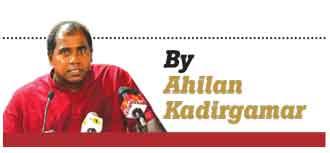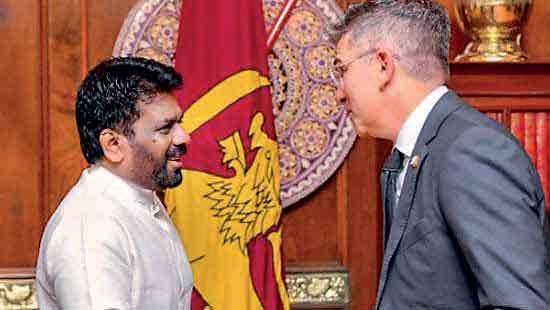Sri Lanka secured USD 200 million from the World Bank’s IDA for Phase 2 of the Resilience, Stability and Economic Turnaround (RESET) programme
 The Western establishment has many ways to corner developing countries like Sri Lanka and set their economic trajectory in the interests of global capital. I have written extensively about the role of the IMF in trapping Sri Lanka with financialised commercial borrowing and austerity measures. In this column, I address the other powerful twin from Washington, the World Bank, and its economic policy-making role in Sri Lanka.
The Western establishment has many ways to corner developing countries like Sri Lanka and set their economic trajectory in the interests of global capital. I have written extensively about the role of the IMF in trapping Sri Lanka with financialised commercial borrowing and austerity measures. In this column, I address the other powerful twin from Washington, the World Bank, and its economic policy-making role in Sri Lanka.
The World Bank’s Sri Lanka Development Update October 2024, released two weeks ago, is a report on the economic situation over the previous year with prescriptions for future policies. In recent times, this report on Sri Lanka is coming out biannually. While the last report in April 2024 was titled, ‘Bridge to Recovery’, the one released this month is titled, ‘Opening Up to the Future’. Carefully written, these economic reports have a political thrust with rhetorical sophistication.
While these reports reinforce the World Bank’s Sri Lanka Country Partnership Framework 2024 to 2027 released in June 2023, and runs parallel to the four-year IMF Agreement of March 2023, they also address recent national and global developments. The World Bank is conscious of the change of regime in Sri Lanka, and the troubles facing the global economy, particularly with economic slowdown and lower trade due to geopolitical conflicts. The World Bank having pushed for regressive laws and economic reforms under the authoritarian Wickremesinghe-Rajapaksa regime over the last year and a half, is now focusing on implementing policies of trade liberalisation, rolling back labour protections and privatisation, under the rubric of export diversification and growth, promotion of tourism and “human capital” development.
Whose recovery and future?
Amidst the discourse of recovery and future, the World Bank candidly acknowledges the socio-economic conditions of the people.
“Households’ budgets have shrunk since 2019, leading to increases in malnutrition and child mortality… prices remain high and moderate food insecurity remains elevated at 23.7 percent in 2023… Poverty is projected to have tripled in urban areas… wages have contracted by 16.9 and 22 percent in the informal private and public sector, respectively, between July 2021 and 2024. Together with job losses, this has resulted in generalised worsening of living conditions, including deteriorating health outcomes. 17.3 percent of children under five years of age were underweight in July 2024, with rates as high as 24.7 percent in poorer districts like Nuwara Eliya posing concerns over persisting structural inequalities. Stunting increased for children at all education levels (grade 1 through 10) between 2022 and 2023 and child mortality continued to increase in 2023.” (World Bank, October 2024, Page 11)
However, the World Bank has nothing to say about supporting this lost generation and relief to the people. It is the same old belief in trickle down recovery once supposedly economic growth picks up.
The World Bank is calling for labour law reforms to attract foreign investment, even though such reforms will take away workers protections, and make the working class, particularly women workers, even more vulnerable to exploitation. Nevertheless, it claims such changes to labour combined with trade liberalisation with export diversification will lead to long-term growth. John Maynard Keynes famously said that in the “long run we are all dead!” In Sri Lanka, we are killing the next generation before our eyes.
But will the World Bank strategy of liberalisation even at such massive human cost work?
“After a brief expansion in April and May 2024, global trade flows returned to their contractionary trend, driven by shrinking merchandise exports, continued conflict, and continued use of trade restricting measures… While global trade growth is expected to accelerate in 2025, it will remain below the 2015–19 average. This growth in trade is expected to be driven increasingly by trade among countries that are aligned on foreign policy.” (World Bank, October 2024, Page 4)
In other words, Sri Lanka is told to export its way out of the crisis by opening up trade, at the very moment when other countries are restricting their markets, and in conditions that are worse than before the pre-crisis years of the late 2010s. Furthermore, even where trade has increased is because of political alignment. Therefore, the World Bank’s push in Sri Lanka, is more about the free trade global order that it hopes to build in the interest of global capital, rather than the realities of addressing the economic depression devastating the country.
The World Bank’s only positive claim about Sri Lanka’s economic recovery is growth in earnings from tourism. But that is because of a near zero base of tourist arrivals with the Covid pandemic. While tourism may expand bringing in valuable foreign exchange, we should also be aware of dynamics of this fickle sector as evident from recent experience. There is also an ulterior motive for the World Bank and great powers to promote tourism as a solution to Sri Lanka’s economic woes. Tourism depends on the goodwill of powerful countries, who can just as easily close the tap of tourist flows if Sri Lanka diverges from their geopolitical interests. Furthermore, the large post-war investments in highways and urban real estate to promote tourism failed to generate returns and precipitated the debt crisis. Clearly, tourism as a strategy of economic development is flawed.
Human capital?
In a world where we should care about people and their social lives, the World Bank’s discourse of “human capital” should be a warning sign of how global capital’s only interest is to seek profits from human life itself. Again, this is what the World Bank has to say:
“[The transition in Sri Lanka] involves gradually increasing private domestic and foreign investment… [with] improvements in human capital and market competition. Upskilling the labor force through vocational training and promoting science-tech-engineering-medicine [STEM] fields in secondary education will create a pool of specialised workers connected to global knowledge flows.” (World Bank, October 2024, Page 28)
The promotion of the domestic and foreign private sector is linked here to the transformation of the educational system. With a sole focus on the STEM education, the question arises as to how many of those youth will remain in the country, or will they merely provide some remittances, the other big foreign exchange earner for the country? Regardless, under the frame of “human capital”, our future generations are to have little of their humanity with them becoming competitive cogs in a world of markets. The pipe dreams of the World Bank peddled in the developing world often come with enticing prefixes like modern, global and commercial. And as mentioned in its ongoing Country Partnership Framework, the World Bank seeks to commercialise universities, making them in reality spaces mainly for wealthy international students, just as the modern infrastructure is for affluent tourists. Even then, they may not come, and they will leave as they wish.
We should be as wary of the World Bank’s development trap as of the IMF’s debt trap. Sri Lanka has two economic development trajectories before it. There is the path of financialisation, trade liberalisation, investment in tourist infrastructure and commercialised education. Alternatively, the path of agricultural production for food security, local investment and production for self-sufficiency, a built environment suitable for its people and universal social welfare including through expansion of free education. The discussions, debates and mobilisations ahead of the parliamentary elections next month, should set a national agenda on this stark choice before our country. Which way is the NPP government headed?

